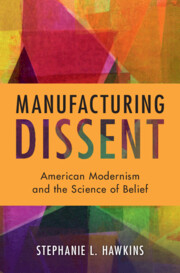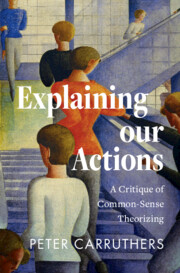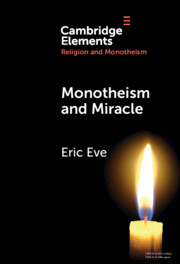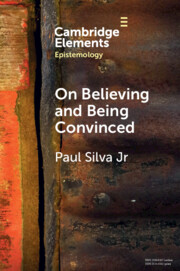Refine search
Actions for selected content:
195 results
Chapter 3 - Hume on Belief
-
-
- Book:
- Hume's <i>A Treatise of Human Nature</i>
- Published online:
- 05 December 2025
- Print publication:
- 08 January 2026, pp 47-63
-
- Chapter
- Export citation
Introduction
-
-
- Book:
- Hume's <i>A Treatise of Human Nature</i>
- Published online:
- 05 December 2025
- Print publication:
- 08 January 2026, pp 1-10
-
- Chapter
- Export citation
Chapter 6 - The Updating Problem for Hume’s Account of Belief in Personal Identity
-
-
- Book:
- Hume's <i>A Treatise of Human Nature</i>
- Published online:
- 05 December 2025
- Print publication:
- 08 January 2026, pp 98-115
-
- Chapter
- Export citation
Chapter 20 - Plutarch
- from Part III - Individuals
-
-
- Book:
- Personal Religion in the Ancient Greek World
- Published online:
- 25 November 2025
- Print publication:
- 11 December 2025, pp 452-466
-
- Chapter
- Export citation
Conclusion
-
- Book:
- Kierkegaard and the Structure of Imagination
- Published online:
- 26 September 2025
- Print publication:
- 16 October 2025, pp 248-256
-
- Chapter
- Export citation

Manufacturing Dissent
- American Modernism and the Science of Belief
-
- Published online:
- 03 October 2025
- Print publication:
- 21 August 2025
Why Demagogues Lie Big
-
- Journal:
- Episteme , First View
- Published online by Cambridge University Press:
- 25 September 2025, pp. 1-22
-
- Article
-
- You have access
- Open access
- HTML
- Export citation
Chapter 2.8 - Paranormal Explanations of NDE-Like Perceptions
- from Part II - Near-Death Experiences
-
- Book:
- Near-Death Experiences
- Published online:
- 30 August 2025
- Print publication:
- 04 September 2025, pp 120-124
-
- Chapter
- Export citation
Introduction
-
- Book:
- Manufacturing Dissent
- Published online:
- 03 October 2025
- Print publication:
- 21 August 2025, pp 1-15
-
- Chapter
- Export citation
Chapter 2 - The Body’s Insistence on Meaning
-
- Book:
- Healing and the Invention of Metaphor
- Published online:
- 17 July 2025
- Print publication:
- 31 July 2025, pp 33-60
-
- Chapter
- Export citation
Chapter 2 - Western Religious Cults
- from Section 1 - Typology
-
-
- Book:
- A Clinical and Forensic Guide to Cults and Persuasive Leadership
- Published online:
- 19 June 2025
- Print publication:
- 03 July 2025, pp 18-52
-
- Chapter
- Export citation
2 - Decision Problems
- from Part I - Decision Problems
-
- Book:
- From Decision Theory to Game Theory
- Published online:
- 17 June 2025
- Print publication:
- 19 June 2025, pp 11-80
-
- Chapter
- Export citation
5 - How Do Children Learn So Much So Quickly?
- from Section I - The Early Years
-
- Book:
- Child Development
- Published online:
- 19 June 2025
- Print publication:
- 12 June 2025, pp 67-85
-
- Chapter
- Export citation
Chapter 7 - Belief, Judgment, and Knowledge
-
- Book:
- Explaining our Actions
- Published online:
- 17 April 2025
- Print publication:
- 08 May 2025, pp 135-157
-
- Chapter
- Export citation

Explaining our Actions
- A Critique of Common-Sense Theorizing
-
- Published online:
- 17 April 2025
- Print publication:
- 08 May 2025
GREEK ATHEISM: A MIRAGE
-
- Journal:
- Greece & Rome / Volume 72 / Issue 1 / April 2025
- Published online by Cambridge University Press:
- 18 March 2025, pp. 88-108
- Print publication:
- April 2025
-
- Article
- Export citation

Monotheism and Miracle
-
- Published online:
- 06 February 2025
- Print publication:
- 13 February 2025
-
- Element
- Export citation

On Believing and Being Convinced
-
- Published online:
- 30 January 2025
- Print publication:
- 30 January 2025
-
- Element
- Export citation
4 - The Efficacy of Empirical Vision for Belief
- from Part II - Seeing God
-
- Book:
- Jesus and the Visibility of God
- Published online:
- 18 January 2025
- Print publication:
- 23 January 2025, pp 137-168
-
- Chapter
- Export citation
